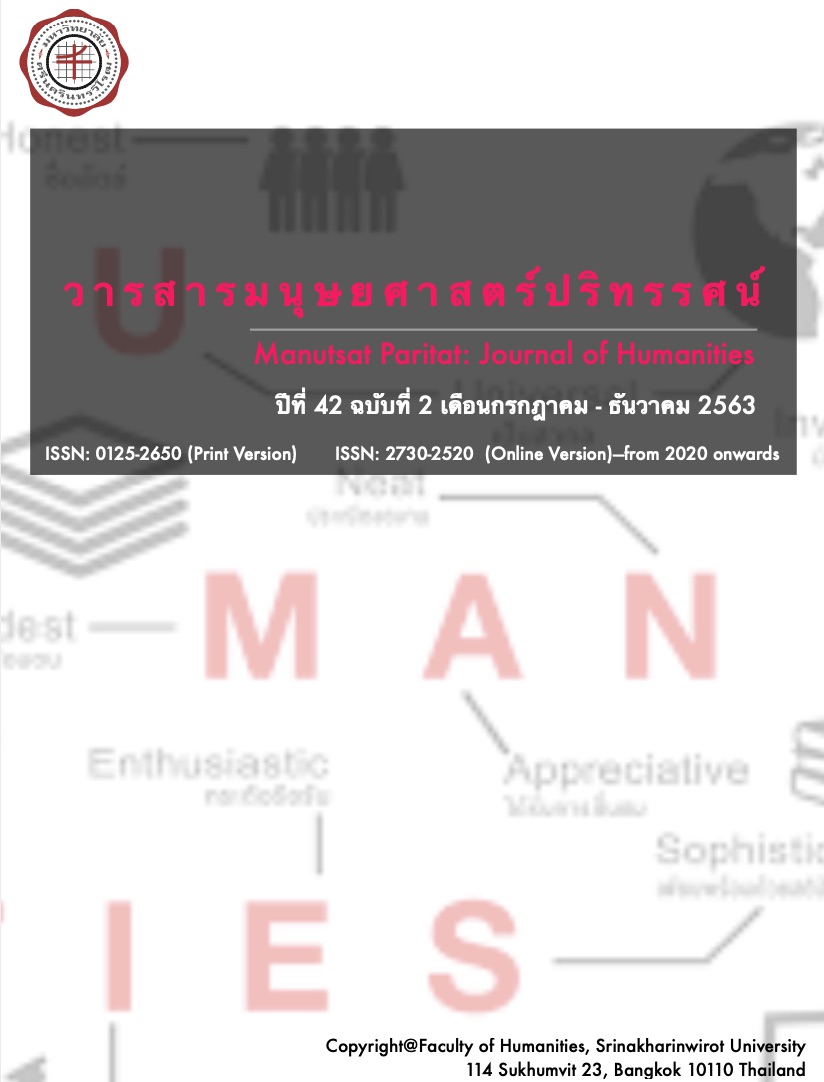Contemporary ‘Little Women’ and Womanhood Perceptions of Thai Young Women
Main Article Content
Abstract
This article lent itself to a qualitative analysis of current and popular female characters in the 2019 film adaptation ‘Little Women’ and Thai young women[1]’s perceptions toward the characteristics of womanhood the characters depicted. This current study was divided into two parts. The first section was the textual analysis to look at how the four main female characters used language both verbal and non-verbal cues to reflect characteristics of womanhood. In the second part, 34 Thai female university students were asked to rate the 15 characteristics of womanhood which emerged from the textual analysis part, on the 4-point Likert scale, ranging from 0-3 (not important at all to very important). The findings from the first part exhibited a combination of traditional and contemporary womanhood in each female character. The perceptions of the sample group highlighted preferences toward prevalent characteristics of contemporary womanhood over those of traditional one. Being independent, educated, negotiators; sentimental; and independent were preferred over being dependent, a wife, and a mother in fulfilling a woman’s role in this contemporary time. Such preference tends to underly women’s economic determinism, financial independence and security while highlighting self-expressionism.
[1] WHO defines young people or young adults as individuals of the age range between 10 and 24 years (World Health Organization South-East Asia, n.d.).
Article Details

This work is licensed under a Creative Commons Attribution-NonCommercial-NoDerivatives 4.0 International License.
Any unauthorized copying, publication, reproduction or distribution of copyrighted works appeared in Manutsat Paritat: Journal of Humanities is an infringement of the copyright owners’ rights. To authorize the copying, publication, reproduction or distribution of copyrighted works to be appeared in other printed materials or any online media, please write to MPJHthaijo@gmail.com for permission.
References
Acocella, J. (August 20, 2018). How “Little Women” got big. The New Yorker. Retrieved from https://www.newyorker.com/magazine/2018/08/27/how-little-women-got-big on
July 1, 2019
Bolotin, S. (1982). Voices from the post-feminist generation. The New York Times. Retrieved from https://www.nytimes.com/1982/10/17/magazine/voices-from-the-post-feminist-generation.html on July 1, 2019
Breznican, A. (December 17, 2019). Little Women has a little man problem. Vanity Fair. Retrieved from https://www.vanityfair.com/hollywood/2019/12/little-women-awards-season-men on July 1, 2019
Cruea, S. M. (2005). Changing Ideals of Womanhood During the Nineteenth-Century Woman Movement. General Studies Writing Faculty Publications. 1. Retrieved from https://scholarworks.bgsu.edu/gsw_pub/1 on July 1, 2019
Drucker, S.A. (April 27, 2018). Betty Friedan: The three waves of feminism. Ohio Humanities Blog and News. Retrieved from http://www.ohiohumanities.org/betty-friedan-the-three-waves-of-feminism/
on July 2, 2020
Durham, M. (1999). Articulating adolescent girls’ resistance to patriarchal discourse in popular media. Women’s Studies in Communication, 22(2): 210-229.
Frevert, U. (2013). Emotion in history: Lost and found. Budapest: Central European University Press.
Hall, S. (1984). Reconstruction Work. 10, 2(9): 340.
Hall, S. (1993). Encoding, decoding. In S. During (Ed.), The Cultural Studies Reader, 2nd ed.
(pp. 507-517). New York: Routledge.
Jeanes, R. (2011). ‘I’m into high heels and make up but I still love football’: Exploring gender identity and football participation with preadolescent girls. Soccer & Society, 12(3): 402- 420.
Korobov, N., & Thorne, A. (2009). The negotiation of compulsory romance in young women friends’ stories about romantic heterosexual experiences. Feminism and Psychology, 19: 49-70.
Levant, R., Richmond, K., Cook, S., House, A.T., & Aupont, M. (2007). The femininity ideology scale: Factor structure reliability, convergent and discriminant validity, and social contextual variation. Sex Roles, 57: 373-383. doi: 10.1007/s11199-007-9258-5
Lorber, J. (1994). Night to his day: The social construction of gender. Paradoxes of Gender. Yale University Press.
Painter, C., & Ferrucci, P. (2012). Unprofessional, ineffective, and weak: A textual analysis of the portrayal of female journalists on sports night. Journal of Mass Media Ethics, 27(4): 248-262.
Poltecha, S. (2018). Stereotypical depiction of Thai women in Hollywood films. Master Thesis. Thammasat University, Bangkok, Thailand. Retrieved from http://ethesisarchive.library.tu.ac.th/thesis/2017/TU_2017_5406040245_8895_7102.pdf on July 3, 2020
Roussell, S. O. (2013). An analysis of femininity: How popular female characters in the media portray contemporary womanhood. Master's Thesis. Louisiana State University, Louisiana, USA. Retrieved from https://digitalcommons.lsu.edu/gradschool_theses/3089 on July 2, 2020
Schwartz, E. (December 18, 2019). Every generation gets its own ‘Little Women’. The Nation. Retrieved from https://www.thenation.com/article/archive/little-women-film-review/ on July 1, 2020
Sheinbaum, H. (February 16, 2020). Unmarried, happily ever after. The New York Times. Retrieved from https://www.nytimes.com/2020/02/15/fashion/weddings/unmarried-happily-ever-after.html on July 3, 2020
Tantiwiramanond, D., & Pandey, S. (1987). The status and role of Thai women in pre-modern period: A historical and cultural perspective. Sojourn: Journal of Social Issues in Southeast Asia, 1(2): 125-149.
Welter, B. (1976). Dimity convictions: The American woman in the nineteenth century. Athens: Ohio University Press.
Wongsupachainimit, S. (2016). The study of status and roles of female characters in Nara’s novels. Burapha University’s Master Thesis. Retrieved from http://digital_collect.lib.buu.ac.th/dcms/files/52921173.pdf on July 2, 2020
World Health Organization South-East Asia. (n.d.). Adolescent health. https://www.who.int/southeastasia/health-topics/adolescent-health


